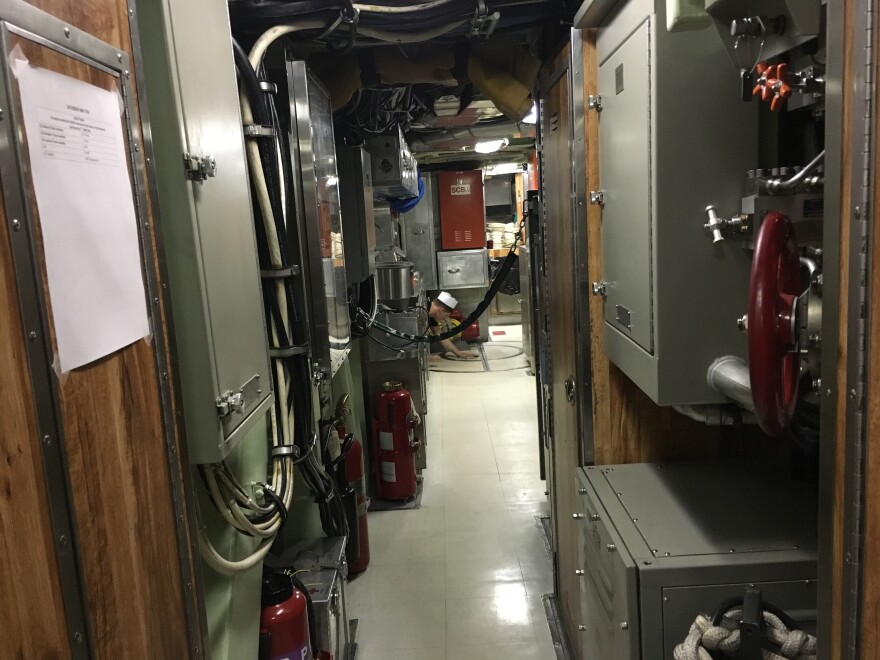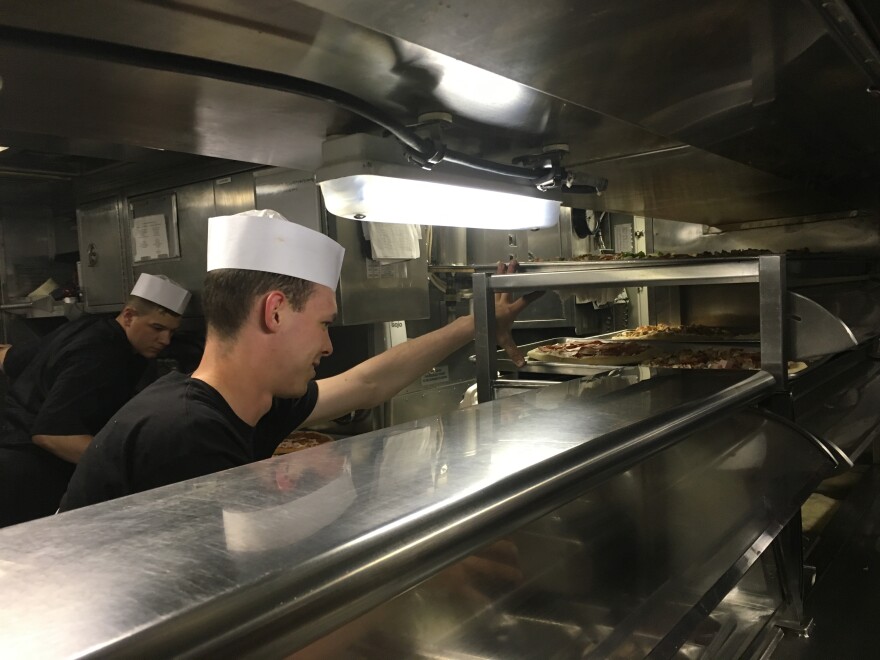You are always in someone’s way on the nuclear submarine USS California.
People can only pass in the hall sideways. Head clearance isn't very generous, either. Most of the crew sleep in “racks” of three bunk beds that are hardly ever unoccupied. They call it “hot racking,” where men on different shifts rotate through their precious sleep time.

But this submarine looks almost exactly the way subs do in the movies. (OK, minus the periscope, and it’s all digitized now.) The control room is dimly lit from glowing screens; men huddle around a chart of the sea floor with their course mapped out.
This week a small flotilla of Navy vessels—including the USS California—is docked at Port Everglades for Fleet Week. Civilians can tour the boats while sailors get a bit of down time. One officer, on the way down from Port Canaveral, said Fleet Week gives the public a chance to see the boats it owns.
Other than the fact that people walk around with mini-radiation detectors on their belts, one of the first things you notice about being on a nuclear submarine is how compact and deliberate everything is. The cramped hallways are lined with hoses and wires and knobs and buttons.
It looks like the inner workings of a factory, and in many ways it is one.
The USS California is a warship. It’s a Virginia Class submarine, which means it contains a small nuclear plant that can power the ship indefinitely. No need to refuel.

Much of what the sub does is intelligence-gathering, and it’s capable of launching missiles (see video below). Its biggest advantage compared to surface destroyers and aircraft carriers is its stealth. Boats on the water's surface have trouble detecting this kind of submarine.
The flip side: There are no portholes or periscope on the submarine when it's underwater. The crew can’t see out, so they navigate with maps and sonar, using complex algorithms and years of experience to predict where the submarine is at any given moment.
When the ship resurfaced after one night of traveling south, it was a few yards off where the command had predicted. It’s part of what makes a boat like this a bit scary and a bit miraculous at the same time.
Life on a ship like this is equally fascinating for newcomers. Here are a few snapshots of life on the USS California.

A SUB IN FLORIDA?
The USS California will soon be deployed at sea, a six-month secret mission to an undisclosed place. In the meantime the crew is constantly doing various types of training, which is presumably why the boat is heading to South Florida.
Say a submarine is setting out for a place like the Strait of Hormuz, in between the Gulf of Oman and the Persian Gulf, one of the busiest stretches of water in the world. You’ve got to practice maneuvering and tracking; and with its shipping traffic, commercial fishermen and the occasional drunk party boat, South Florida is a great training ground.
Because these submarines have no eyes, they rely pretty heavily on their ears. Senior Chief Erik Gemaly has spent years listening to sonar. Check out some of the things experts like him hear:

FOOD
When the submarine dives however many hundreds of feet underwater, it leaves the crew cut off from the ebb and flow of life on land. You don’t get to talk to family or get email. There's very little news or sports--the only TV is what people bring on board on DVDs. Even when the boat surfaces, the email system works at “AOL dial-up speed,” one officer said.
So food is really important to keeping morale up and to building community around chow time.
Submarines like this are completely self-sufficient. The USS California has systems that can make everything it needs, including oxygen, drinking water and electrical power.
The only limiting factor is food, and Culinary Specialist Chief Joseph Appold is in charge of it.
“Our number one mission as culinary specialists is to sustain the ship out to sea as long as possible,” said Appold. “So how we load food, how we order food, how we plan to serve that food contributes to the ship staying out for, say, 90 days versus 95 days.”
"How we load food, how we order food, how we plan to serve that food contributes to the ship staying out for, say, 90 days versus 95 days" -- Joseph Appold, Culinary Specialist Chief
The Navy sends those culinary hands to school, which gives them fundamentals on cooking and planning, but it's hardly the Cordon Bleu.

"Really what I operate on is pure unadulterated experience,” says Appold. “Just the things that I’ve seen work on a submarine, what we can actually get in terms of the catalog [of] what we order from and then how that translates to the moving target called lunch and dinner.”
Moving target because the mess hall isn’t just used for eating. It is also host to trainings and briefings, so mealtimes move around a lot.
The catalog he mentioned is essentially a list of food you can get and it varies based on the port. Florida is known for offering an unusually large selection of fresh fruit, especially citrus. Buying coffee in particular ports is also key, in order to get the better tasting brands. Having ice cream on board—hard pack, not soft serve—is a particular priority for the commander.
On big deployments the boat can stock up to 120 days of food supplies. To pack in more, they line the floor in some places with cans that the crew walk on.
And, especially on a vessel with shifts running 24-hours, the coffee flows constantly.
As for the food, it's not exactly Zagat-rated. Bulk, frozen meat; lots of canned and dehydrated stuff. "There's no fresh stuff when we are out on deployment," Appold said. "Taking that and making that good without fresh ingredients, that’s our challenge.”

LAUNDRY
Crew on board have very little space for their personal belongings—really just the three inches under their bed—so laundry day is very important. You get one shot a week or else it’s dirty shirts and undies week until your next chance at the washer.
And wouldn’t you know, the thing on a nuclear submarine the head electrician has to fix most often is the dryer.
“We’re pretty proficient at tearing them down and putting them back together,” said electrical division Chief John O’Donnell. “In fact it works out because my wife likes--it because I tear our washer and dryer apart and fix it at home as well.”
SILENCE IS GOLDEN
All over the submarine are little gold plaques that say, “Silence is Golden” in English, Russian, Arabic, Mandarin and Latin.

The Latin, Silentium est Aureum, is the ship’s motto, playing on the boat’s California namesake, the Golden State. But it also plays off the unofficial name of the submarine fleet, the silent service. Because sonar is the way submarines of any nation detect surrounding vessels, being quiet on board is part of the deal. Translating the motto into other languages reminds the crew that other nations - and potential foes - could be listening, even at these depths.












